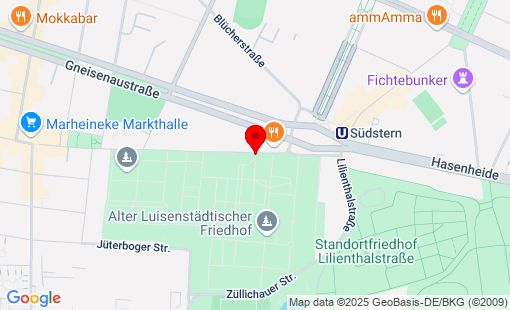Germany
Berlin-Kreuzberg, Jerusalems- und Neue Kirchengemeinde Friedhof IV
Total Occupation: 409 fatalities
Total Occupation: 409 fatalities
Cemetery IV of the Jerusalems- und Neue Kirche parish was consecrated on June 2, 1852 as the last of the four cemeteries on today's Bergmannstraße in Kreuzberg; Friedrichswerdersche Friedhof II has been located on its western border since 1844 and the (Alte) Luisenstädtische Friedhof on its eastern border since 1831. The four cemeteries are considered the most species-rich green space in Berlin with a particularly high density of breeding birds. The 3.1 hectare cemetery is the fourth of the former Jerusalem parish; the first three were located in the complex of six cemeteries in front of Hallesches Tor. The Jerusalemskirche was first mentioned in writing in 1484 as the "Capelle Hierusalem". in 1725-1731, a new church, now also known as the "Friedrichstädtische", was built according to designs by Philipp Gerlach. in 1838, the church was given a slender spire designed by Karl Friedrich Schinkel, with a final remodelling of the large church with 1,366 seats in 1878-1879. Due to the changes in the cityscape around 1900, the congregation lost more and more members and was merged with the congregation of the Neue Kirche. On February 3, 1945, the church was almost completely destroyed in an air raid; the ruins were blown up in 1961. The Axel Springer House has stood on part of the original site since 1966. On Rudi-Dutschke-Straße, the ground plan of the former Jerusalemskirche is marked with a double row of red stones as a reminder. A new church was built on Lindenstrasse and Markgrafenstrasse in 1968. Some salvaged rubble stones from the old church are attached to the façade of the new one. Following the amalgamation of the parish in 2001, the church was rededicated as a venue for events in 2007. The cemetery contains the graves of various personalities: - Carl Aschinger (1855-1909), founded the "Aschinger" with his brother August in 1892, which soon became the largest restaurant in Europe - Maximilian Fretter-Pico (1892-1984), officer in the First World War and artillery general in the Second World War - Hermann von der Hude (1830-1908), historicist architect (including work on the Berlin Cathedral and the Berlin Palace) - Maximilian Fretter-Pico (1892-1984), officer in the First World War and artillery general in the Second World War.franz Jaffé (1855-1937), painter, decorator and film architect - Max Krause (1838-1913), paper manufacturer - Rikard Nordraak (1842-1866), Norwegian composer (e.g. of the Norwegian national anthem) of the Norwegian national anthem); in 1925 his remains were moved to the Norwegian National Cemetery in Oslo (the grave in Berlin, redesigned in 1906, has been preserved) - Arthur Rohmer (1830-1898), architect of brewery complexes - Fritz Schaper (1841-1919), sculptor of, among other things, the pediment on thefritz Schaper (1841-1919), sculptor of the pediment on the Reichstag building and numerous statues throughout Germany (honorary grave) - Kurd von Schlözer (1822-1894), diplomat and writer (honorary grave) - Werner Schroeter (1945-2010), film, theater and opera director - Max Weber sen. (1836-1897), lawyer, national liberal politician and father of the sociologist Max Weber There are also other artistically significant mausoleums and gravestones, such as the bronze sculpture of the sleeping Chronos by Hans Latt on the grave of the merchant Georg Wolff (1856-1904) or the Art Nouveau sculpture on the grave of Margot Leonhardt (1886-1904).
There are 123 individual graves of victims of the Second World War, mainly civilian dead, in Cemetery IV of the Jerusalems- und Neue Kirche parish (Martin Bayer, 16.04.2020)
